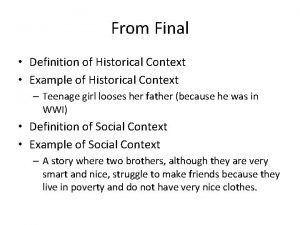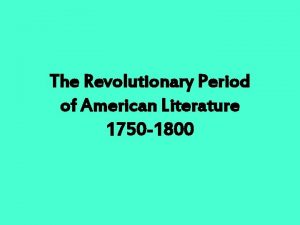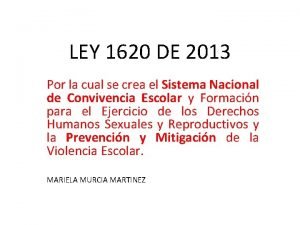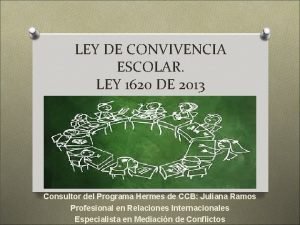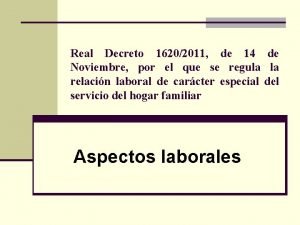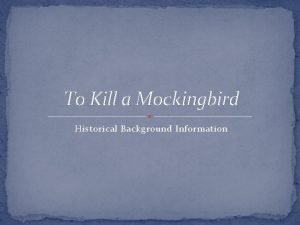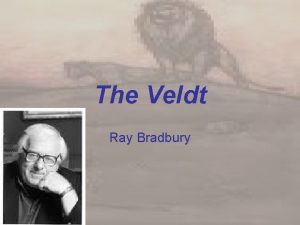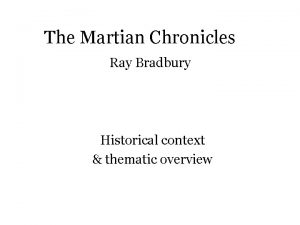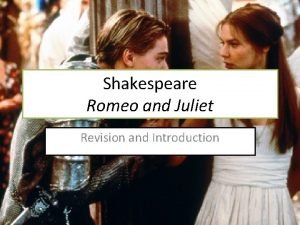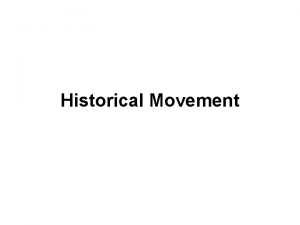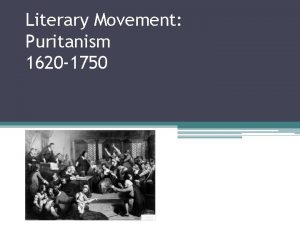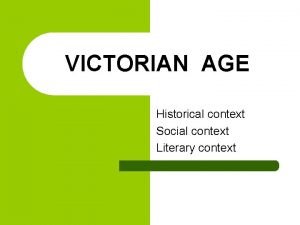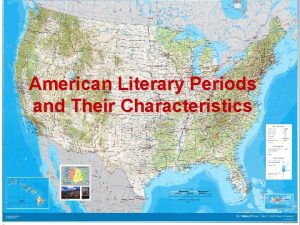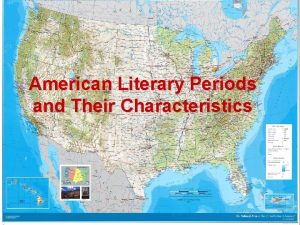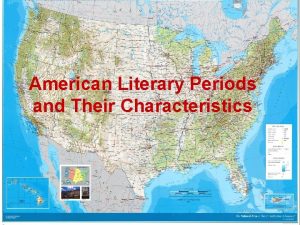Literary Movement PuritanColonial Literature 1620 1750 Historical Context











- Slides: 11

Literary Movement: Puritan/Colonial Literature 1620 -1750

Historical Context n n n 1620 Mayflower lands at Plymouth 1630 Great Migration of Puritans to New England 1690 Slavery exists in all English Colonies in North America 1721 Smallpox epidemic hits Boston 1740 -45 Great Awakening

Worldview n “Age of Faith” (to be followed by “Age of Reason”) n n Religious authority and tradition as means of knowing truth Puritanism was the dominant shaping force of the early American worldview. Puritans believed: n n n Humans are inherently sinful. Salvation belongs to God’s elect, who are saved by grace. A person should be hardworking, modest, and simple. n n “Puritan Work Ethic” Society should be modeled after the Bible.

Common Elements of the Literature n Characteristics of Puritan literature: n n Authors modeled their writings after the Bible. They used their writings to explore God’s workings in their inner and outer lives. Diaries and histories were the most common forms of expression. Puritans favored a “plain style” of writing.

Common Elements of the Literature n Narratives (both Puritan and non-Puritan) recorded a variety of individuals’ experiences in the New World n n Travel Narratives (Cabeza de Vaca) Tales of Life in North America (John Smith) Captivity Stories (Mary Rowlandson) Slave Narratives (Olaudah Equiano) * See Elements of Literature p. 43

Famous Authors n n n William Bradford, Of Plymouth Plantation (1620 -47) Mary Rowlandson, A Narrative of Captivity (1682) William Byrd, The History of the Dividing Line (1728) Jonathan Edwards, “Sinners in the Hands of an Angry God” (1741) Olaudah Equiano, The Interesting Narrative of the Life of Olaudah Equiano (1789)

from Of Plymouth Plantation n About the Author: William Bradford n n Came to the New World aboard the Mayflower in 1620 with a group of Separatists Wife Dorothy either fell or jumped overboard Was elected governor of the Plymouth Colony thirty times Literary Concept: Plain style is a way of writing that stresses simplicity and clarity of expression.

From The History of the Dividing Line n About the Author: William Byrd n n n Born in Virginia in 1674 to a wealthy landowner and merchant Educated in England preferred London (lavish, intellectual community, gambling) Shared the Cavalier perspective n n Unlike the Puritans, the Cavaliers enjoyed British intellectual and social trends “Renaissance Man”: translator, poet, mathematician, farmer

From The History of the Dividing Line n Literary Concepts: n n Satire is a type of writing that ridicules the shortcomings of people or institutions in an attempt to bring about a change Tone is the writer’s attitude toward the subject of the work, the characters, or the audience

From A Narrative of the Captivity n About the Author: Mary Rowlandson (1636 -1711) n n Born in England, sailed for Salem in 1639 Wife of Joseph Rowlandson, a Congregational minister in Lancaster, a frontier town thirty miles west of Boston Taken captive by the Wampanoag after they raided her town, along with her three children Literary Terms n n n Captivity narratives related the experiences of colonists who were kidnapped by Native Americans. An allusion is a reference to someone or something well known from literature, religion, politics, sports, science, or some other aspect of culture. Chronological order presents events in the order in which they occurred.

From A Narrative of the Captivity n n Historical Context n An estimated 7 -18 million Native Americans north of the Rio Grande pre-1600 n Scholars have recently estimated a North American Indian population of 2 -5 million pre-1600 n By 1890, an estimated 228, 000 North American Indians n Following the arrival of European explorers and colonists, native populations dramatically decreased due to disease, starvation, and warfare. n King Phillip’s War (1675 -76) was the most devastating war between the Native Americans and the colonists in New England. Named after King Philip, the sachem (chief) of the Wampanoag, who was Massasoit’s son. Source of population statistics: A Population History of North America by Michael R. Haines and Richard H. Steckel
 Background context examples
Background context examples American literature revolutionary period
American literature revolutionary period Ley 1620
Ley 1620 Ley 1620 de 2013 situaciones tipo 1 2 y 3
Ley 1620 de 2013 situaciones tipo 1 2 y 3 San mateo 28 1620
San mateo 28 1620 Ruta de convivencia escolar ley 1620
Ruta de convivencia escolar ley 1620 Rd 1620/2011
Rd 1620/2011 What is historical significance
What is historical significance Background information on to kill a mockingbird
Background information on to kill a mockingbird Symbols in the veldt
Symbols in the veldt Ray bradbury the pedestrian context
Ray bradbury the pedestrian context Courtly love in romeo and juliet
Courtly love in romeo and juliet
